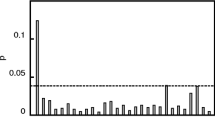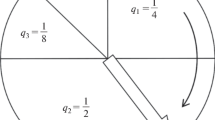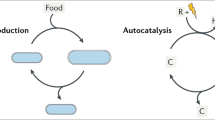Summary
A theory is described for the origin of a simple chemical system named an autogen, consisting of two short oligonucleotide sequences coding for two simple catalytic peptides. If the theory is valid, under appropriate conditions the autogen would be capable of self-reproduction in a truly genetic process involving both replication and translation. Limited catalytic ability, short oligomer sequences, and low selectivities leading to sloppy information transfer processes are shown to be adequate for the origin of the autogen from random background oligomers. A series of discrete steps, each highly probable if certain minimum requirements and boundary conditions are satisfied, lead to exponential increase in population of all components in the system due to autocatalysis and hypercyclic organization. Nucleation of the components and exponential increase to macroscopic amounts could occur in times on the order of weeks. The feasibility of the theory depends on a number of factors, including the capability of simple protoenzymes to provide moderate enhancements of the accuracies of replication and translation and the likelihood of finding an environment where all of the required processes can occur simultaneously. Regardless of whether or not the specific form proposed for the autogen proves to be feasible, the theory suggests that the first self-replicating chemical systems may have been extremely simple, and that the period of time required for chemical evolution prior to Darwinian natural selection may have been far shorter than generally assumed. Due to the short time required, this theory, unlike others on the origin of genetic processes, is potentially capable of direct experimental verification. A number of prerequisites leading up to such an experiment are suggested, and some have been fulfilled. If successful, such an experiment would be the first laboratory demonstration of the spontaneous emergence by natural selection of a genetic, self-replicating, and evolving molecular system, and might represent the first step in the prebiotic environment of true Darwinian evolution toward a living cell.
Similar content being viewed by others
References
Behme MTA, Fullington JG, Noel R, Cordes EH (1965). J Amer Chem Soc 87:266–270
Bender ML (1971) Mechanism of homogeneous catalysis from protons to proteins. Wiley-Interscience, New York, p 360
Black S (1970) Nature 226:754–755
Blum HF (1957) In: Rudnick D (ed), Rhythmic and synthetic processes in growth. Princeton University Press, Princeton, p 155
Brooks J, Shaw G (1978) In: Noda H (ed) Origin of life. Center for Academic Publications, Tokyo, p 569
Bruice TC, Benkovic SJ (1966) Bioorganic mechanisms, vol 1. Benjamin, New York
Bunton CA, Robinson L (1970) J Amer Chem Soc 92:356–361
Carter CW Jr, Kraut J (1974) Proc Nat Acad Sci USA 71:283–287
Crick FHC (1966) Cold Spring Harbor Symp Quant Biol 31:3–9
Crick FHC (1968) J Mol Biol 38:367–379
Dose K (1975) Bio Systems 6:224–228
Eigen M, Schuster P (1977) Naturwissenschaften 64:541–565
Eigen M, Schuster P (1978a) Naturwissenschaften 65:7–41
Eigen M, Schuster P (1978b) Naturwissenschaften 65:341–369
Fendler JH, Fendler EJ (1975) Catalysis in micellar and macromolecular systems. Academic Press, New York
Fife TH (1975) Adv Phys Org Chem 11:1–22
Gitler C, Ochoa-Solano A (1968) J Amer Chem Soc 90:5004–5009
Haldane JBS (1929) Rationalist Annual 148
Haldane JBS (1965) In: Fox SW (ed) The origins of prebiological systems and of their molecular matrices. Academic Press, New York, p 11
Hammond GS (1953) J Amer Chem Soc 77:334–338
Herries DG, Bishop W, Richards FM (1964) J Phys Chem 68:1842–1852
Hine J (1975) Structural effects on equilibria in organic chemistry. Wiley-Interscience, New York
Hirsch JA (1974) Concepts in theoretical organic chemistry. Allyn and Bacon, Boston, p 88
Hoffmann GW (1975) Annu Rev Phys Chem 26:123–144
Horowitz NH, Miller SL (1962) Forschr Chem Org Naturst 20:423–459
Kenyon DH, Steinman G (1969) Biochemical predestination. Mc-Graw Hill, New York, p 163
Keosian J (1978) In: Noda H (ed), Origin of life, Center for Academic Publications Japan, Tokyo, p 564
Kirsch JF, Jencks WP (1964) J Amer Chem Soc 86:837–846
Kuhn H (1972) Angew Chem Int Ed Engl 11:798–820
Lahav N, Chang S (1976) J Mol Evol 8:357–380
Lahav N, White DH (1980) J Mol Evol 16:11–21
Lahav N, White D, Chang S (1978) Science 201:67–69
Lohrmann R, Orgel LE (1979) J Mol Evol 14:243–250
Mizutani H, Ponnamperuma C (1977) Origins life 8:183–219
Mora PT (1965) In: Fox SW (ed), The origins of prebiological systems and of their molecular matrices. Academic Press, New York, p 39
Nakashima T, Fox SW (1972) Proc Nat Acad Sci USA 69:106–108
Ninio J, Orgel LE (1978) J Mol Evol 12:91–99
Oparin AI (1938) The origin of life. MacMillan, New York, pp 164, 251 [republished (1953) Dover, New York]
Orgel LE (1968) J Mol Biol 38:381–393
Orgel LE, Lohrmann R (1974) Accts Chem Research 7:368–377
OróJ (1968) J Br Interplanet. Soc 21:12–25
Overberger CG, Okamoto Y (1972) Macromolecules 5:363–368
Overberger CG, Salamone JC, Yaroslavsky S (1967) J Amer Chem Soc 89:6231–6236
Pattee HH (1965) Ad Enzymol 27:381–415
Pirie NW (1954) New Biology 16:40–53
Prigogine I, Nicolis G (1971) Quart Rev Biophys 4:107–148
Pross A (1977) Adv Phys Org Chem 14:69–132
Royer GP, Klotz IM (1969) J Amer Chem Soc 91:5885–5886
Sagan C (1974) Origins Life 5:497–505
Tagaki W, Amada T, Yamashita Y, Yano Y (1972) J Chem Soc Chem Commun 1131–1132
Usher DA (1977) Science 196:311–313
Van Etten RL, Sebastian JF, Clowes GA, Bender ML (1967) J Amer Chem Soc 89:3242–3253
Wells PR (1968) Linear free energy relationship. Academic Press, London
Whitaker JR, Deatherage FE (1955) J Amer Chem Soc 77:3360–3365
White DH (1980) Proceedings of Sixth Inter Conf on Orig Life, Jerusalem, June 22–26. Internat Soc Study Orig Life (in press)
White DH, Erickson JC (1980) J Mol Evol 16 (in press)
White DH, Erickson JC (1981) J Mol Evol 17 (in press)
Woese CR (1967) The genetic code. Harper and Row, New York
Woese CR (1970) Bioscience 20:471–485
Woese CR (1973) J Mol Evol 2:205–208
Author information
Authors and Affiliations
Rights and permissions
About this article
Cite this article
White, D.H. A theory for the origin of a self-replicating chemical system. I: Natural selection of the autogen from short, random oligomers. J Mol Evol 16, 121–147 (1980). https://doi.org/10.1007/BF01731582
Received:
Revised:
Issue Date:
DOI: https://doi.org/10.1007/BF01731582




